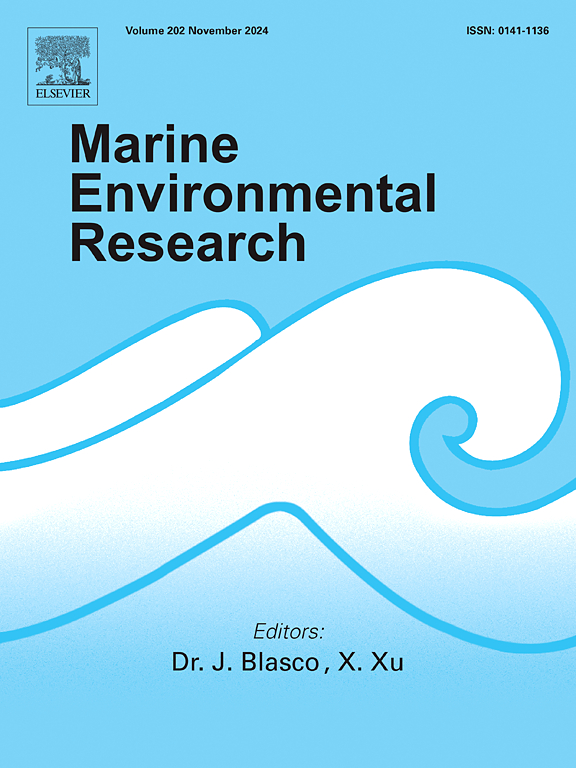地中海东部超低营养盐海域海豚之间的生态互动和独特资源分配。
IF 3
3区 环境科学与生态学
Q2 ENVIRONMENTAL SCIENCES
引用次数: 0
摘要
本研究深入探讨了以色列南部地中海沿岸超低营养水域中三个海豚物种的生态动力学,其中两个是内栖海豚:普通瓶鼻海豚(Tursiops truncatus)和普通海豚(Delphinus delphis),一个是中上层海豚:条纹海豚(Stenella coeruleoalba)。它利用对单个氨基酸的特定化合物稳定同位素分析来研究碳源和氮源的变化以及这三个物种之间的营养定位。对搁浅个体的肌肉样本进行了氨基酸碳(δ13C)和氮(δ15N)同位素比值分析,其中δδ15N(谷氨酸-苯丙氨酸)是相对营养位置的指标。研究结果表明,不同物种之间的碳源特征和营养位置略有不同,但氮源特征却截然不同。后者表明瓶鼻海豚和条纹海豚有不同的觅食栖息地,并表明普通海豚在白天和夜间分别在浅海底和深海水层觅食区之间转换,这是它们生存策略的一部分。本文章由计算机程序翻译,如有差异,请以英文原文为准。
Ecological interactions and unique resource partitioning between dolphins in the ultraoligotrophic eastern Mediterranean Sea
This study delves into the eco-dynamics of three dolphin species in the ultra-oligotrophic waters off the southern Israeli Mediterranean coast - two neritic: the common bottlenose dolphin (Tursiops truncatus) and the common dolphin (Delphinus delphis) and one pelagic: the striped dolphin (Stenella coeruleoalba). It utilizes compound-specific stable isotope analysis of individual amino acids to investigate carbon and nitrogen source variability and trophic positioning among the three species. Muscle samples from stranded individuals were analyzed for carbon (δ13C) and nitrogen (δ15N) isotopic ratios of amino acids, with Δδ15N (Glutamate-Phenylalanine) acting as an indicator of relative trophic position. The findings reveal minor differences in carbon source signatures and trophic position among species, but distinct nitrogen source signatures. The latter indicate discrete foraging habitats for bottlenose and striped dolphins and suggest that common dolphins transition between shallow benthic and deep pelagic feeding areas during the day and night, respectively, as part of their survival strategy.
求助全文
通过发布文献求助,成功后即可免费获取论文全文。
去求助
来源期刊

Marine environmental research
环境科学-毒理学
CiteScore
5.90
自引率
3.00%
发文量
217
审稿时长
46 days
期刊介绍:
Marine Environmental Research publishes original research papers on chemical, physical, and biological interactions in the oceans and coastal waters. The journal serves as a forum for new information on biology, chemistry, and toxicology and syntheses that advance understanding of marine environmental processes.
Submission of multidisciplinary studies is encouraged. Studies that utilize experimental approaches to clarify the roles of anthropogenic and natural causes of changes in marine ecosystems are especially welcome, as are those studies that represent new developments of a theoretical or conceptual aspect of marine science. All papers published in this journal are reviewed by qualified peers prior to acceptance and publication. Examples of topics considered to be appropriate for the journal include, but are not limited to, the following:
– The extent, persistence, and consequences of change and the recovery from such change in natural marine systems
– The biochemical, physiological, and ecological consequences of contaminants to marine organisms and ecosystems
– The biogeochemistry of naturally occurring and anthropogenic substances
– Models that describe and predict the above processes
– Monitoring studies, to the extent that their results provide new information on functional processes
– Methodological papers describing improved quantitative techniques for the marine sciences.
 求助内容:
求助内容: 应助结果提醒方式:
应助结果提醒方式:


